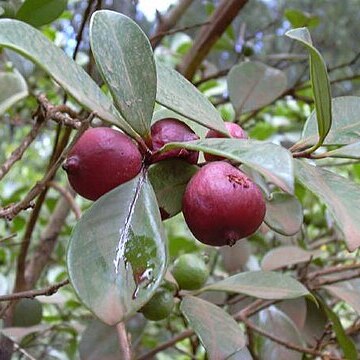Large shrub or small tree to 6 m high. Trunk smooth, pale brown. Shoots terete or subterete, puberulent when young. Petioles 7-10 mm long, puberulent. Lamina 4-8 × 2.5-4.5 cm, obovate, ciliolate toward base of margins and midrib, at least when young, otherwise glabrous, dotted with glands beneath, glossy and dark green above; lateral veins fairly conspicuous in dried material but not impressed or markedly raised; base cuneate, often narrowly so; apex usually obtuse, sometimes rounded. Fls solitary, often produced in nearly all axils of upper lvs; pedicels 7-10 mm long, puberulent, jointed near apex with very small, caducous, ovate bracteoles. Hypanthium and calyx limb glandular-punctate; lobes usually 5, 3-4 mm long. Petals c. 5 mm long, elliptic, white, ± glandular-punctate. Stamens > petals. Style c. 4 mm long, stout. Fr. ± globose, c. 2 cm diam., becoming dark purple, occasionally yellow; flesh usually purple, occasionally whitish, sweet. Seeds numerous.
More
An evergreen shrub. It grows 3-6 m high. The young shoots are rounded. They can be hairy or smooth. The leaf stalk is 4-15 mm long. Leaves are dark green and shiny above and 4-6 cm x 2-3 cm. The edges of the leaves curl backwards. The leaves are wedge shaped at the base. There are several glands under the leaf. Flowers are white and singly in the axils of leaves. The flower stalk is 3-7 mm long. It has small round red or purplish fruit. The flesh is white. There are several hard seeds inside. The seeds are 3 mm long by 2.5 mm wide. The fruit are edible.
A tropical plant. It is native to Brazil. It does quite well in highland areas in the tropics. It grows from sea level to 1,900 m. It is more frost resistant than common guava. It can be grown on a range of soils. It is fairly drought resistant. It suits hardiness zones 8-12. In Hobart Botanical gardens. Melbourne Botanical gardens. In Yunnan.
More
Littoral levees and forests. Atlantic rainforest and evergreen Araucaria forest, found mainly in lowland coastal forests; favouring the more open areas in moist soils.
Littoral levees and forests. Atlantic rainforest and evergreen Araucaria forest, found mainly in lowland coastal forests; favouring the more open areas in moist soils.
Plants are grown by seed, suckers or cuttings. It can also be grown by layering. Pruning helps fruit production. It can be pruned to form a hedge. The ripe fruit are harvested and the seed removed and washed in running water then dried in the shade. Seed will remain viable for 4 months. Fresh seed should be planted and they germinate in 20-40 days.

